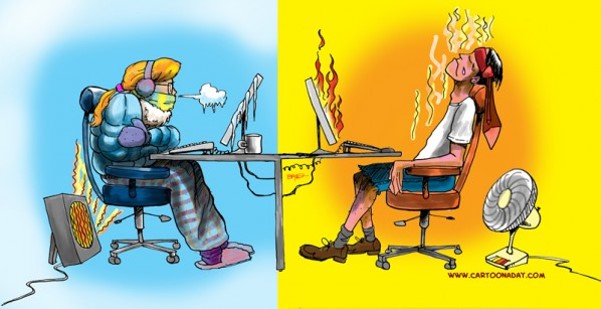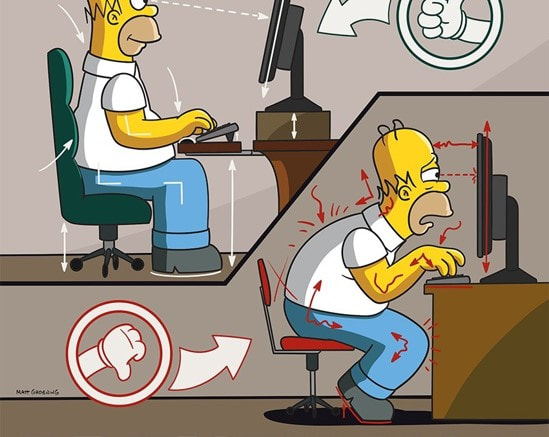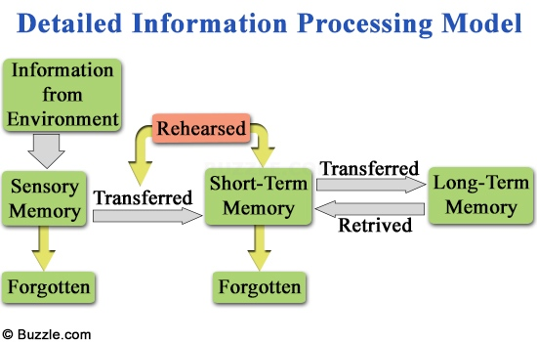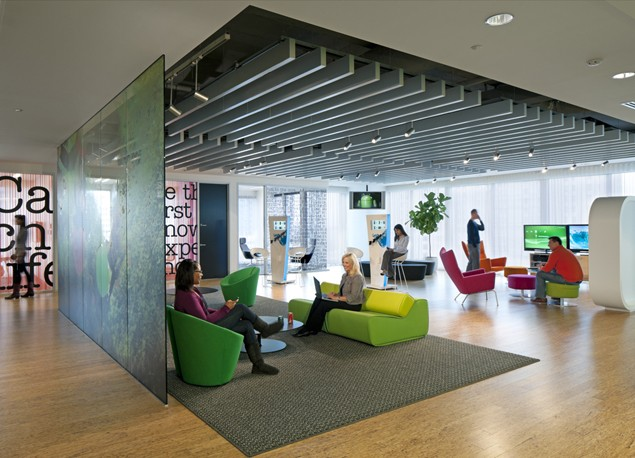1.1b Psychological factors
|
Outline the significance of psychological factors (smell, light, sound, taste, texture and temperature) to ergonomics. Individuals react differently to sensory stimuli. Efficiency and comfort are effected by such factors. A designer must be aware of the affects that temperature, sound, light, taste, smell and colour form on the perceptions of users and how they influence the designed environment.
Psychological factors are those that impact operations including effects of environmental conditions.
These can be affected by an individuals reactions to a range of sensory stimuli. Methods of collecting this data is normally in the form of interviews, questionnaires and observations. This makes it Qualitative data and therefore hard to graph, interpret and form measurable data. It is difficult to translate it to Quantitative data. |
-Temperature: Heating conditions in work and leisure, comfort zones e.g. car interior heating systems.
-Sound: Efficiency in exhaust systems for sound deadening (cars). ’Walkman’ – volume ranges for comfort and sound quality (also ‘passive’ listeners). Effect on concentration levels (e.g. machinery noise – safety issues).
-Light: Lighting in workplaces, safety. E.g. effects of florescent lighting and rotating parts on machinery (i.e. strobe effect). Lighting effect on ambience and mood e.g. lighting in restaurants – gentle, calming, stimulating.
-Texture: Appreciation of textile qualities and their applications in design situations. e.g. smoothness of kitchen work surfaces for reasons of hygiene, tiles around a swimming pool (i.e. roughened surface to prevent slipping when wet).
-Colour: Effects on emotions. e.g. sense of ‘warmth’ and ‘coldness’ i.e. ‘warm’ red/orange/yellow, ‘cool’ violet/green/blue. The use and application of such knowledge in the designed environment. e.g. decoration, symbols, artefacts. Colour association used in design: red- danger/stop/beware; green – go/safety; white –cleanliness. (Imagine trying to sell brown nappies or black washing powder!). Also the importance of various colours in certain religions or cultures may be a factor.
-Smell/ Taste: Aroma dispensers to provide an expected smell (e.g. fresh bread, coffee odours in supermarkets) or to mask other odours e.g. cigarette smoke in bars.
-Comfort: What is comfortable for one person may be less comfortable for another.
-Humidity: Individuals can cope/manage different degrees of humidity. Dependent on their acclimatisation, culture, geographical up bringing. Each individual is different.
-Sound: Efficiency in exhaust systems for sound deadening (cars). ’Walkman’ – volume ranges for comfort and sound quality (also ‘passive’ listeners). Effect on concentration levels (e.g. machinery noise – safety issues).
-Light: Lighting in workplaces, safety. E.g. effects of florescent lighting and rotating parts on machinery (i.e. strobe effect). Lighting effect on ambience and mood e.g. lighting in restaurants – gentle, calming, stimulating.
-Texture: Appreciation of textile qualities and their applications in design situations. e.g. smoothness of kitchen work surfaces for reasons of hygiene, tiles around a swimming pool (i.e. roughened surface to prevent slipping when wet).
-Colour: Effects on emotions. e.g. sense of ‘warmth’ and ‘coldness’ i.e. ‘warm’ red/orange/yellow, ‘cool’ violet/green/blue. The use and application of such knowledge in the designed environment. e.g. decoration, symbols, artefacts. Colour association used in design: red- danger/stop/beware; green – go/safety; white –cleanliness. (Imagine trying to sell brown nappies or black washing powder!). Also the importance of various colours in certain religions or cultures may be a factor.
-Smell/ Taste: Aroma dispensers to provide an expected smell (e.g. fresh bread, coffee odours in supermarkets) or to mask other odours e.g. cigarette smoke in bars.
-Comfort: What is comfortable for one person may be less comfortable for another.
-Humidity: Individuals can cope/manage different degrees of humidity. Dependent on their acclimatisation, culture, geographical up bringing. Each individual is different.
|
Effect of environmental factors
Environmental factors include, sound, temperature, lighting, air quality (pollutants) and smell. The user responds to different environmental factors, for example, how warm or cold work environments can affect the performance of an individual. Thermal comfort describes a person’s psychological state of mind and involves a range of environmental factors: air temperature, the heat radiating from the Sun, fires and other heat sources, air velocity (still air makes people feel stuffy, moving air increases heat loss), humidity, and personal factors (clothing and metabolic rate). Hopefully in an office environment where a number of people work together, the thermal environment satisfies the majority of the people. Thermal comfort is not measured by air temperature, but by the number of people complaining of thermal discomfort. Thermal comfort affects morale and productivity. Environmental factors can affect different individuals in different ways. Individuals react differently to sensory stimuli. Efficiency and comfort are affected by such factors. It becomes important to optimize environmental factors to maximize workplace performance. This can be challenging as user responses to environmental factors are different, some people will find 22 c perfect while for other it may to be cold! |
Human information processing systems
Human information processing system can be represented using a flow chart. Below is a flow diagram; the arrows represent the flow of information through the system. The boxes represent functional elements in the processing chain, where information is processed.
Human information processing system can be represented using a flow chart. Below is a flow diagram; the arrows represent the flow of information through the system. The boxes represent functional elements in the processing chain, where information is processed.
Complete the below information flow diagram for when you use a mobile phone.
Complete the below information flow diagram for when you are driving a car and you see a Red traffic light
up ahead. What are the processes that occur.
up ahead. What are the processes that occur.
Psychological factor data
Psychological factors include, smell, light, sound, taste, texture and temperature. These are a significant part of ergonomics and human efficiency and safety can be affected by these factors.
Methods of collecting psychological factor data
Data Collection through 4 types of measurement scales
Psychological factors include, smell, light, sound, taste, texture and temperature. These are a significant part of ergonomics and human efficiency and safety can be affected by these factors.
Methods of collecting psychological factor data
Data Collection through 4 types of measurement scales
|
|
|
Nominal Scale
The nominal type differentiates between items or subjects based only on their names: Examples of these classifications include gender, nationality, ethnicity, language, genre, style, biological species, and form
Ordinal Scale
The ordinal type allows for rank order (1st, 2nd, 3rd, etc.) by which data can be sorted, but still does not allow for relative degree of difference between them. Examples include, on one hand, dichotomous data with dichotomous (or dichotomized) values such as 'sick' vs. 'healthy' when measuring health, 'guilty' vs. 'innocent' when making judgments in courts, 'wrong/false' vs. 'right/true'
Interval Scale
The interval type allows for the degree of difference between items, but not the ratio between them. Examples include temperature with the Celsius scale, which has two defined points (the freezing and boiling point of water at specific conditions) and then separated into 100 intervals
Ratio Scale
The ratio type takes its name from the fact that measurement is the estimation of the ratio between a magnitude of a continuous quantity and a unit magnitude of the same kind. A ratio scale possesses a meaningful (unique and non-arbitrary) zero value. Most measurement in the physical sciences and engineering is done on ratio scales. Examples include mass, length, duration, energy and electric charge. In contrast to interval scales, ratios are now meaningful because having a non-arbitrary zero point makes it meaningful to say, for example, that one object has "twice the length" of another (= is "twice as long"). The Kelvin temperature scale is a ratio scale because it has a unique, non-arbitrary zero point called absolute zero.
The nominal type differentiates between items or subjects based only on their names: Examples of these classifications include gender, nationality, ethnicity, language, genre, style, biological species, and form
Ordinal Scale
The ordinal type allows for rank order (1st, 2nd, 3rd, etc.) by which data can be sorted, but still does not allow for relative degree of difference between them. Examples include, on one hand, dichotomous data with dichotomous (or dichotomized) values such as 'sick' vs. 'healthy' when measuring health, 'guilty' vs. 'innocent' when making judgments in courts, 'wrong/false' vs. 'right/true'
Interval Scale
The interval type allows for the degree of difference between items, but not the ratio between them. Examples include temperature with the Celsius scale, which has two defined points (the freezing and boiling point of water at specific conditions) and then separated into 100 intervals
Ratio Scale
The ratio type takes its name from the fact that measurement is the estimation of the ratio between a magnitude of a continuous quantity and a unit magnitude of the same kind. A ratio scale possesses a meaningful (unique and non-arbitrary) zero value. Most measurement in the physical sciences and engineering is done on ratio scales. Examples include mass, length, duration, energy and electric charge. In contrast to interval scales, ratios are now meaningful because having a non-arbitrary zero point makes it meaningful to say, for example, that one object has "twice the length" of another (= is "twice as long"). The Kelvin temperature scale is a ratio scale because it has a unique, non-arbitrary zero point called absolute zero.
Breakdown in the Human Information Processing System.
|
A breakdown in the processing system can happen at any stage. This may be due to:
•Age: maybe too young to have experience or too old to react quick enough. •Size and Strength: may physically be unable to perform the task. •Skill level •Frailty •Brain damage which may come from a stroke or disability |
An individuals ability to draw information from their surroundings is limited. This limitation is due to:
Cognitive overload Cognitive bottlenecks Or also known as Memory overload. When capacity is exceeded, overload may occur leading to decreased response rates. Individuals will begin a “filtering process” when dealing with too much information. The filtering is primarily derived from past practice, past experience and cultural background. |
Environmental factors
|
The working environment can have serious effect and implications on workers and their performance.
Environmental factors can induce different levels of alertness and impact on the individual performance. •Loud noises/working conditions can decrease alertness •Less than 50db is helpful to concentration •Background noise helps creativity •Sound: too loud which can be distracting or even cause harm, high pitched or repetitive on/off noises also become distracting. |
•Lighting can affect accuracy
•Red and blue night at light can increase alertness •Lighting: too dim hard to see things need to get close or strains the eyes, natural versus fluorescent (can affect peoples eyes) •Temperature: too warm and you get sleepy and less alert – too cold and you become more alert. next time you are on a long haul flight note the temperature fluctuations while flying. •Smell – bad smells will draw ones attention away as would the smell of a hot apple pie |
Environmental factors can affect different individuals in different ways. Individuals react differently to sensory stimuli. Efficiency and comfort are affected by such factors. It becomes important to optimize environmental factors to maximize workplace performance. This can be challenging as user responses to environmental factors are different, some people will find 22 c perfect while for other it may to be cold!
|
It is important to control environmental factors as to maximize workplace performance.
Critical factors include: •Thermal comfort. •Air quality •Building acoustics •Lighting •Worker densities •Open plan offices -Unrestricted space -Reducing the number of interior walls -Lowering or removing walls -Perception of space -Natural light from windows -open communication -more public space -Loss of personal space |
The gathering of Psychological data is not precise because it relies on individual perceptions
|













